Dell Display and Peripheral Manager for macOS
Zusammenfassung: Dell Display and Peripheral Manager (DDPM) is software that enhances productivity and customization for Dell monitors and webcams on macOS.
Dieser Artikel gilt für
Dieser Artikel gilt nicht für
Dieser Artikel ist nicht an ein bestimmtes Produkt gebunden.
In diesem Artikel werden nicht alle Produktversionen aufgeführt.
Weisungen
Dell Display and Peripheral Manager for macOS
Table of Contents:
- How to Download and Install Dell Display and Peripheral Manager?
- What are the Key Features Available for Monitors?
- What are the Key Webcam Features Available for the Dell Webcams and Cameras of Video Conferencing Monitors?
- Which Dell Monitors are Supported on Dell Display and Peripheral Manager for Mac?
- Which Dell Peripherals are Supported on Dell Display and Peripheral Manager for Mac?
- Frequently Asked Questions
Tutorial on Dell Display Manager 2.x
Duration: 10:57
Closed Caption (Multiple Languages)
This video only covers the monitor-related features of Dell Display Manager for macOS. For webcam features, see the User Guide.
NOTE: Dell Display and Peripheral Manager (DDPM) replaces Dell Display Manager for macOS. Download DDPM for macOS to continue using your devices seamlessly.
How to Download and install Dell Display and Peripheral Manager?
- Go to Dell Display and Peripheral Manager. Then select Drivers & Downloads.
- Select Apple Mac OS as the Operating System.
NOTE: The Dell support website detects the Operating System used by your computer to set the Operating System field. If you are using Mac device, the Dell Display and Peripheral Manager download link is displayed for Mac OS. Alternatively, the Operating System can be selected from the Operating System dropdown.
- Click the Download button next to Dell Display and Peripheral Manager.
- Using the Finder, browse to the Downloads folder.
- Double-click the downloaded .zip file to extract the package.
- Go to the extracted folder, install DDPM by running the DDPM_Installer.pkg.
- Follow the installation flow to complete the installation.
- After installation, launch DDPM from Launchpad.
NOTE: DDPM requires Accessibility and Automation permission for the Easy Arrange and Easy Memory to open the documents, resize and arrange them to the selected layout. When prompted by OS, click OK to allow access.
If you have a webcam connected, allow DDPM to access the camera when prompted. Update webcam firmware requires Automation to access the downloaded firmware package and Input Monitoring for the updating tool to update the firmware.
You can also enable these permissions from Privacy and Security under System Settings.
If you have a webcam connected, allow DDPM to access the camera when prompted. Update webcam firmware requires Automation to access the downloaded firmware package and Input Monitoring for the updating tool to update the firmware.
You can also enable these permissions from Privacy and Security under System Settings.
What are the Key Features Available for Monitors?
- Optimal Front of Screen Experience: The Menu Launcher dialog box provides quick access to commonly used features, such as:
- Resolution
- Brightness and Contrast
- Color
- Easy Arrange
- KVM and webcam (if applicable)
To access these controls, click the Dell Display and Peripheral Managers icon on the status bar. When multiple Dell monitors are connected to the Mac, you can select any monitor from the drop-down menu.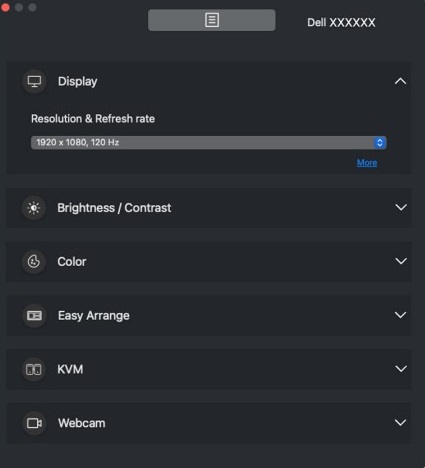
- Display: The Display menu provides a single window to customize display related settings of the monitor such as resolution, refresh rate, orientation, and Smart HDR.
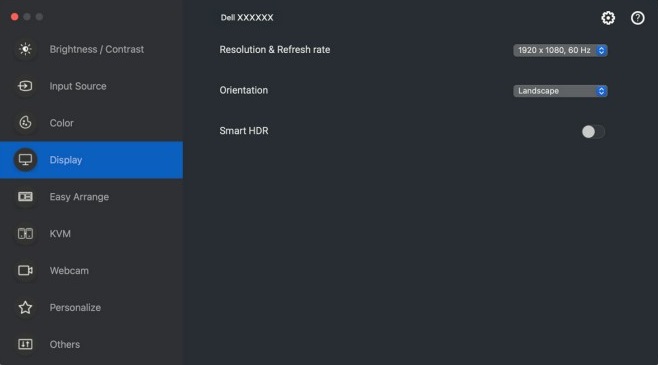
- Brightness and Contrast: This menu enables you to adjust the brightness or contrast settings of their monitor manually and automatically based on their scheduled time.
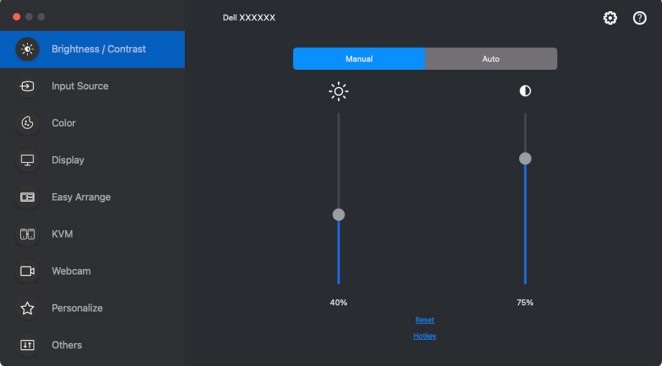
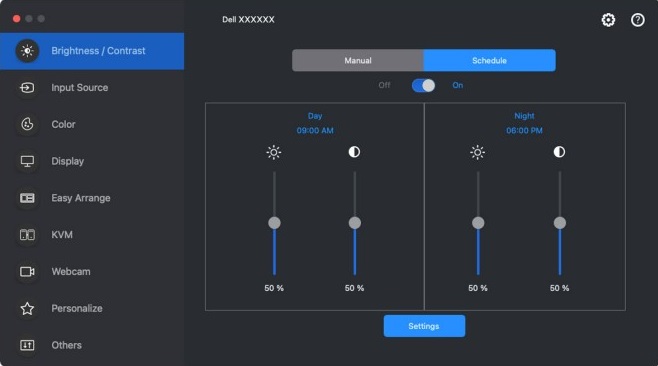
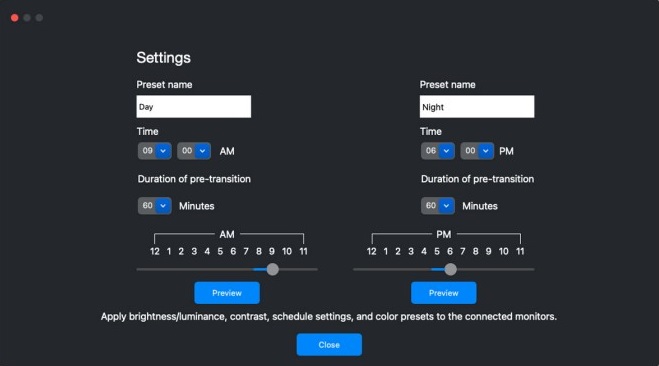
Monitors that have Ambient Light Sensor can use Auto mode to automatically adjust brightness and color temperature based on surrounding light conditions. You can choose to define the brightness range based on your preference.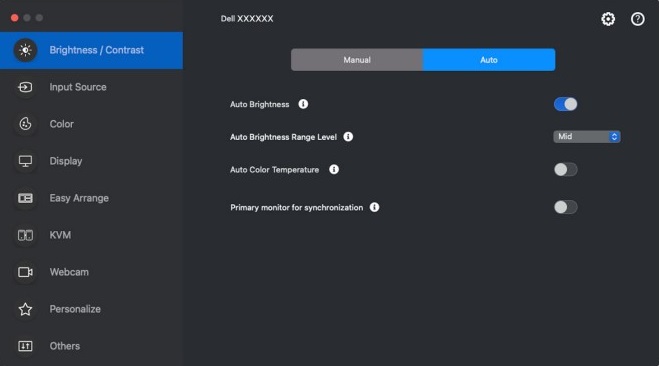
- Input Source: This allows you to manage multiple video inputs on your Dell monitor. This makes it easy to switch between inputs while you work with multiple computers. You can arrange the inputs as Picture in Picture (PIP) or Picture By Picture (PBP) mode.
NOTE: See your monitor User Guide for available inputs and Keyboard, Video, Mouse (KVM) feature availability.
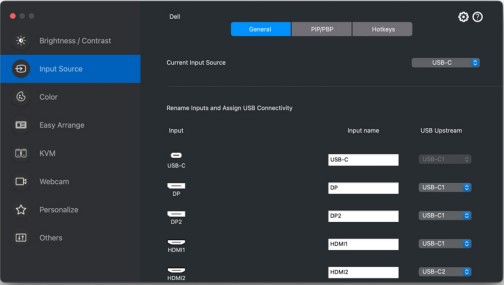
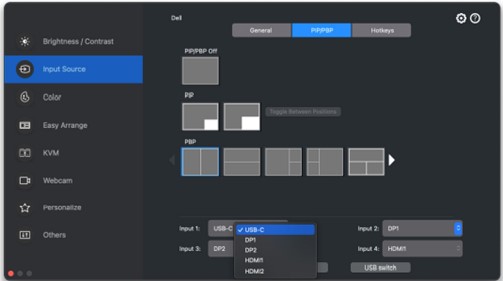
- Color: The Color menu allows you to associate any Preset Mode with an application. When Auto Mode is enabled, the DDPM application automatically switches to the corresponding Preset Mode. This happens whenever the associated application is activated.
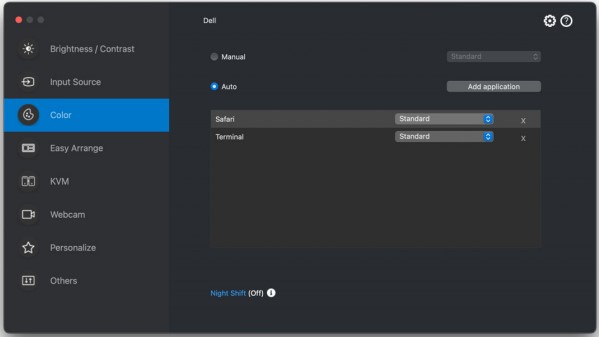
- Easy Arrange: With Easy Arrange, you can organize multiple applications on your screen and snap them into a template of your choice, making multitasking easy and effortless. You can choose from predefined or custom layouts to configure your screen layout.
Easy Arrange can also be used to personalize dual monitors side by side or expand desktop space by spanning across two monitors.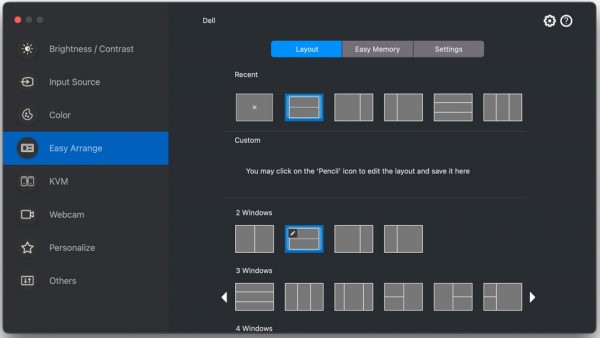
- Easy Arrange Memory: This feature allows you to assign applications or even files to the partitions of Easy Arrange, save the layout to create a profile, and then restore the profile.
NOTE: For each app added to the Easy Memory for the first time, you must explicitly provide automation permission to DDPM. You must click OK when the computer displays the permission dialog.
Clicking Don't Allow causes DDPM to be prohibited from launching the app on its own. You are not able to save the profile.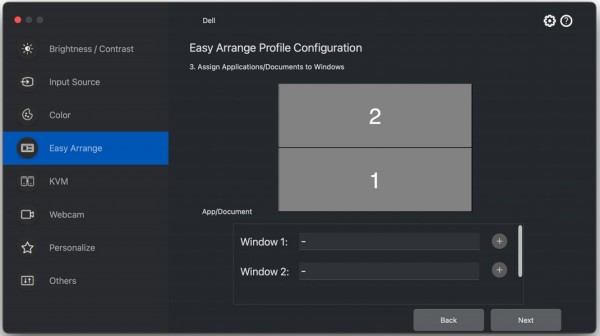 NOTE: Easy Arrange Memory usability may vary according to application type and launch behavior. Easy Memory works with general productivity apps such as Microsoft Office, Adobe, web browsers and more.
NOTE: Easy Arrange Memory usability may vary according to application type and launch behavior. Easy Memory works with general productivity apps such as Microsoft Office, Adobe, web browsers and more.
Easy Memory might not be able to perform a window partition at launch if any of the following takes place:- The app displays a dialog box that appears upon launch (that is, login screen, error dialog, or unsaved files)
- The app is launched in full screen mode
- Files are opened as individual tabs within the app
- Overlapping Easy Arrange layouts
- Application Windows Snap: This feature helps you with placing a program quickly to any screen. When enabled in Dell Display and Peripheral Manager, dragging the application window triggers a floating menu that contains recently used Easy Arrange layouts. You can drop the application to any of the listed layouts to perform window placement.
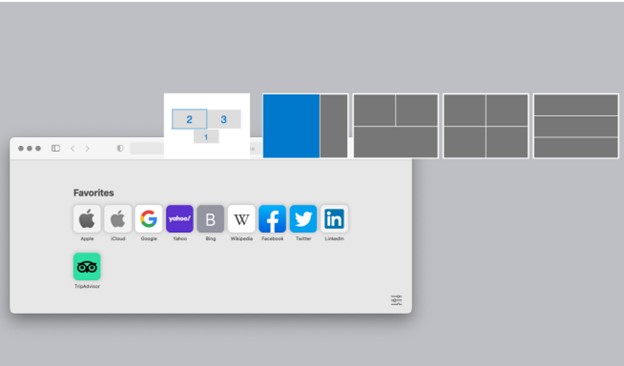
- KVM: Dell Display and Peripheral Manager for macOS offers two ways to setup KVM - USB KVM & Network KVM. The KVM feature is available when connected monitors support KVM functionality.
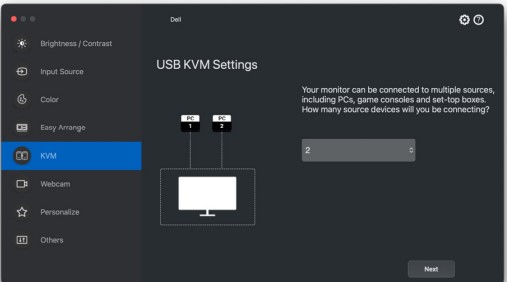
- Network KVM
This feature allows sharing of a keyboard and mouse and transfer of files between client devices in a cluster. Sharing of files is also supported across the OS that is from a Windows device to a macOS device and vice versa.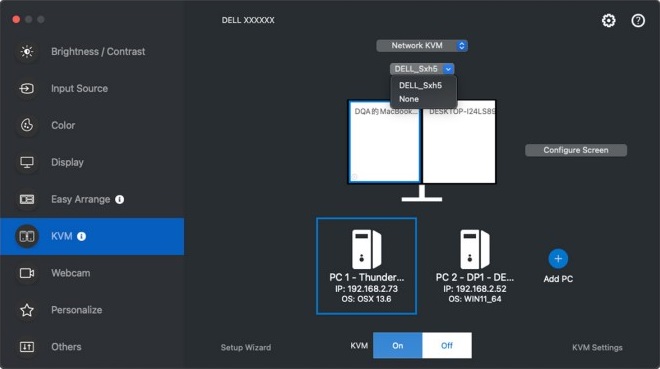
Network KVM Settings
Cluster consists of client device and monitor. A maximum of four client devices can be added to a cluster. You can setup the cluster in three different ways: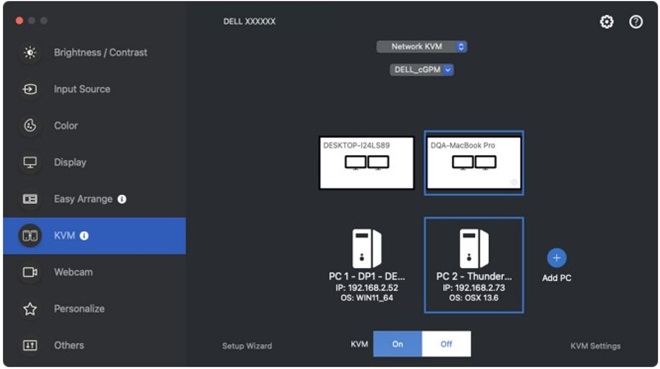
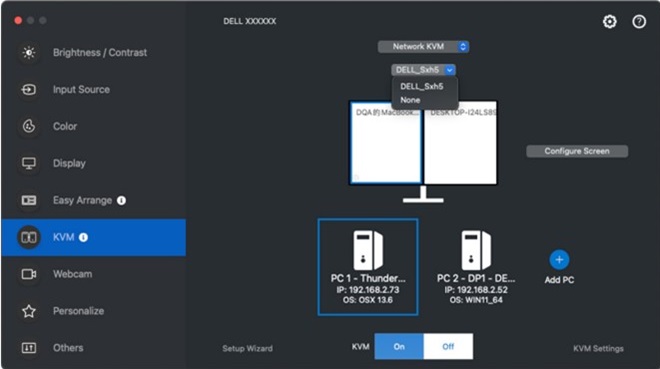
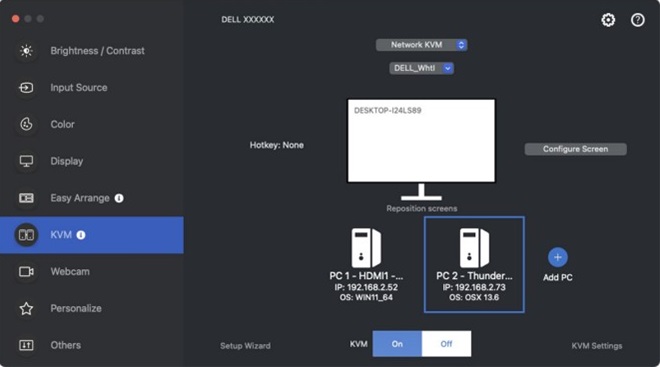 Note:
Note:- Availability of Network KVM features depends on the network policy set out by the company/IT. This feature requires opening of network access control list (ACL) for network incoming/outgoing traffic control.
- Network KVM is modular (optional to install). It does not install by default, and users can choose not to install it while downloading the software and use other features of Dell Display Manager. If users want to install Network KVM later, it requires fresh installation of version 2.3 and above.
- You may experience delayed response from remote computers on Network KVM due to network latency limitations.
- Certain key combinations, function keys, specialized keys, and touch bar keys are not supported for controlling remote computers. While clipboard sharing in a cluster, Cut and Paste is not supported on remote computers.
- The established Cluster may not resume connection after Network KVM is turned back on from the off state, after the main computer is woken from suspension, or after connecting to a supported monitor. In this case, you may manually switch the cluster from the drop-down list, or you may manually connect the offline computer from the Network KVM main page.
- Dell Display Manager enables secure content and file sharing between computers with end-to-end encryption. However, it does not function as anti-malware software, providing no scanning or protection against malicious files during transfers. It is recommended to install anti-malware or other security tools before using File and Content Transfer in Network KVM. If you prefer not to share files between computers, you can navigate to KVM Settings and use Manage Cluster to turn off this feature.
- If your cluster has a mix of Windows and Mac devices, connect keyboard and mouse to Mac if possible as remote mac device cannot be accessed.
- It is not recommended to turn on both-Apple Universal Control and Network KVM as it might cause confusion.
- For details on how to setup refer Setting up the Network KVM section of the user guide available at: Dell Display and Peripheral Manager | Manuals and Documents
- Network KVM
- USB- C Prioritization: Users can select option for High Data speed priority or High Resolution through USB-C prioritization option available under Advanced settings of the Display menu.
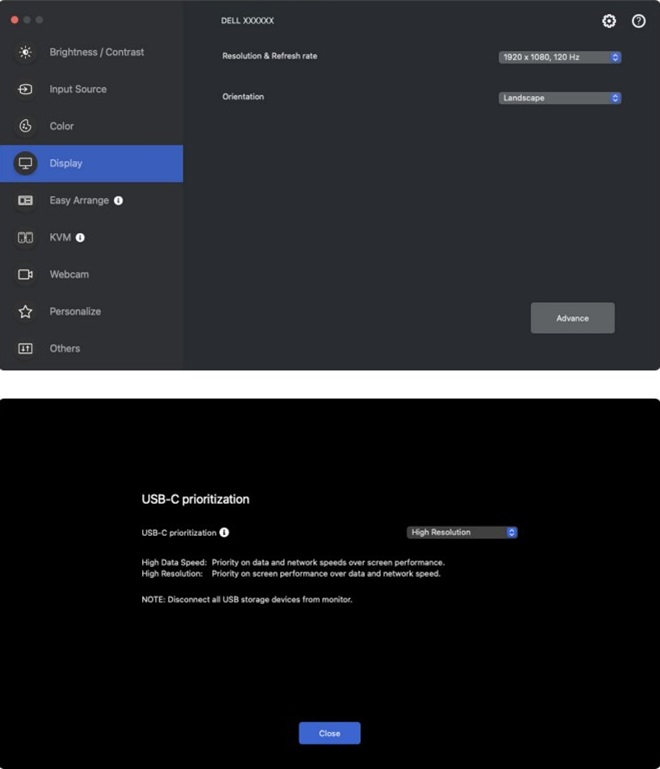
- Power Conservation: On supported Dell models, PowerNap energy conservation options are available in the Others menu. You can choose to set the brightness of the monitor to the minimum level, or to put the monitor to sleep when the screen saver is activated.
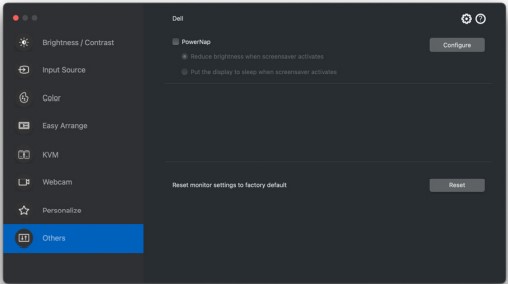
- Color Management: This feature allows you to sync the color space of the monitor with the associated International Color Consortium (ICC) profile.
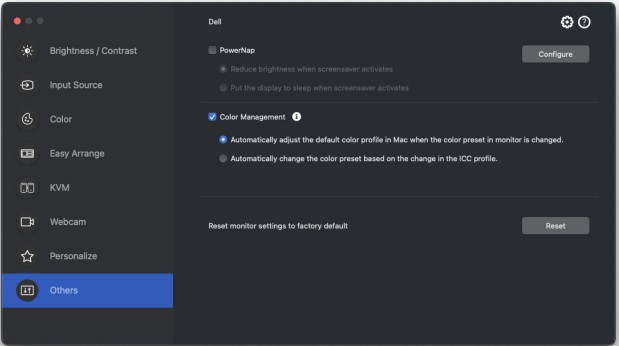
What are the Key Webcam Features Available for the Dell Webcams and Cameras of Video Conferencing Monitors?
- Webcam Control Features
- AI Auto Framing
AI auto-framing keeps you at the center of the picture by tracking your movement and adjusting accordingly. - Field of View (FOV) adjustment
This feature allows you to customize how much you want to show yourself and your surroundings.- 65° FOV: Best for face-to-face conversations
- 78° FOV: Provides a glimpse of your environment while maintaining eye contact
- 90° FOV: Wide-angle, ideal for showing objects or whiteboard content
- Other features available are Preset, Autofocus, Exposure, and Priority.
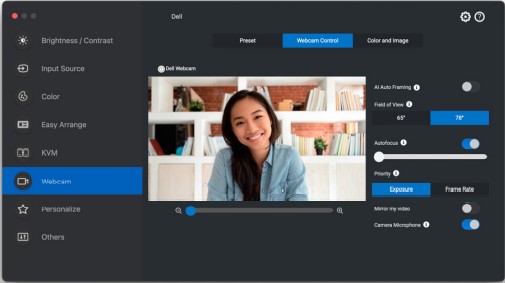
- AI Auto Framing
- Color and Image: This option allows you to achieve optimal image quality at various lighting conditions using High Dynamic Range (HDR). Other settings like Auto White Balance, Brightness, Sharpness, Contrast, Saturation, and Anti Flicker for the Dell webcam makes it easier to get an image of your choice.
NOTE: AI Auto Framing and HDR are available on the WB7022 webcam when it is connected to the Mac using a USB 3.0 cable.
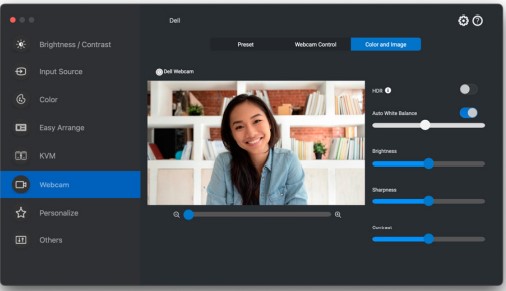
- Camera Microphone: You can switch the integrated microphone on or off for clear communication optimized for your personal workspace.
NOTE: A microphone is available on the WB5023 webcams.
- Firmware Updates: Firmware can be upgraded in the Settings dialog. You can click Update to download and update Dell webcam firmware immediately.
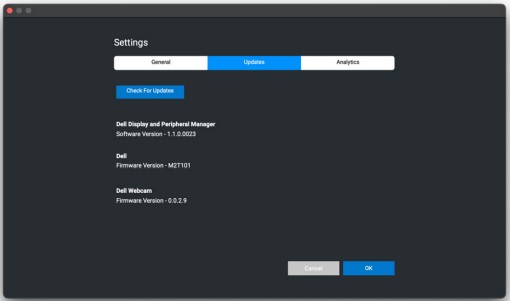
- Remote Management and Control (for IT Managers Only): Dell Display and Peripheral Manager use CLI commands for the following:
- Asset management Querying monitor inventory logs
- Display info and Monitor control: Query the current monitor settings and to set basic monitor settings such as brightness, color preset, volume, resolution and much more.
- Export and import settings: Export Settings command writes all DDPM settings for all active monitors to the designated file. Import Settings command reads all the settings recorded in the designated filename and assigns them to other monitors of the same model.
NOTE: CLI commands are restricted for IT managers only. Contact a Dell sales representative for more information.
Which Dell Monitors are Supported on Dell Display and Peripheral Manager for Mac?
| Dell C Series Monitors | Dell P Series Monitors | Dell S Series Monitors | Dell UltraSharp (U) Series Monitors | Dell UltraSharp PremierColor (UP) Series Monitors |
|---|---|---|---|---|
| C5519Q | P2424HEB (Webcam Features Also Available for this Model) |
S2725QC | U3219Q | UP2720Q |
| C5519QA | P2724DEB (Webcam Features Also Available for this Model) |
S3225QC | U3419W | UP2720QA |
| C5522QT | P3424WEB (Webcam Features Also Available for this Model) |
S3425DW | U4919DW | UP3221Q |
| C6522QT | P5524Q | U2520D | ||
| C7520QT | P5524QT | U2520DR | ||
| C8621QT | P6524QT | U2720Q | ||
| C2422HE | P7524QT | U2720QM | ||
| C2722DE | P8624QT | U4320Q | ||
| C3422WE | P2425E | U2421E | ||
| C2423H | P2425HE | U2421HE | ||
| C2723H | P2725HE | U2721DE | ||
| P5525QC | U3421WE | |||
| P2425DE | U3821DW | |||
| P2725DE | U4021QW | |||
| P2725QE | U2422H | |||
| P3225DE | U2422HE | |||
| P3225QE | U2422HX | |||
| P3425WE | U2722D | |||
| P7525QT | U2722DE | |||
| U2722DX | ||||
| U2723QE | ||||
| U2723QX | ||||
| U3023E | ||||
| U3223QE | ||||
| U3223QZ (Webcam Features Also Available for this Model) |
||||
| U3423WE | ||||
| U4323QE | ||||
| U3224KB (Webcam Features Also Available for this Model) |
||||
| U3224KBA (Webcam Features Also Available for this Model) |
||||
| U4924DW | ||||
| U2424H | ||||
| U2424HE | ||||
| U2724D | ||||
| U2724DE | ||||
| U3824DW | ||||
| U3425WE | ||||
| U4025QW | ||||
| U2725QE | ||||
| U3225QE |
Note: Note that webcam features on Dell Display and Peripheral Manager for Mac are only available for select monitor models as indicated in Table 1.
Which Dell Peripherals are Supported on Dell Display and Peripheral Manager for Mac?
| Dell Webcams |
|---|
| WB7022 |
| WB3023 |
| WB5023 |
Frequently Asked Questions
- Is Dell Display and Peripheral Manager for macOS supported on a VDI Desktop?
Dell Display and Peripheral Manager for macOS does not support VDI Desktop or other virtualized environment. - Does the Dell Display and Peripheral Manager Software Work on All Apple Products?
The Dell Display and Peripheral Manager supports the following devices launched after 2018- MacBook Pro MacBook Air, Mac Mini, Mac Pro, Mac Studio. It does not support the iMac. macOS versions 12, 13, 14, 15 are supported. - Must I Update my Dell Display Firmware to Support Dell Display and Peripheral Manager for Mac?
Yes, your Dell monitor must be updated to the latest firmware version to work with Dell Display and Peripheral Manager for Mac.
To update display firmware:- Go to the Dell Drivers & Downloads page.
- Enter your Monitor Model Number or Service Tag.
- Select Apple Mac OS and download the firmware package.
- Connect your Type-C or Thunderbolt cable to your monitor, Run the Firmware Package, and follow the on-screen instructions to complete the firmware update for your monitor.
NOTE: The firmware update may take several minutes to complete. Disable sleep mode on your Mac when updating your monitor firmware.- Some hardware-dependent features are only available on monitors or webcams that support those features. See your monitor or webcams User Guide for information about which features are available.
- Screenshots in this document are for illustrative purposes only. The User Interface (UI) might appear different if some features are not available in your monitor or accessory.
- For details on each feature mentioned here, see User Guide for Dell Display and Peripheral Manager for macOS at Dell Product Documentation for your Dell monitor.
Weitere Informationen
Please bookmark our supporting article What is Dell Display Manager and the download page Dell Display and Peripheral Manager for future reference.
Betroffene Produkte
Dell C2423H, Dell C2723H Monitor, Dell C5519QA, Dell 24 Video Conferencing Monitor C2422HE, Dell 27 Video Conferencing Monitor C2722DE, Dell 34 Video Conferencing Curved Monitor C3422WE, Dell C5519Q, Dell C5522QT, Dell C6522QT, Dell C7520QT
, Dell C8621QT, Dell Pro Webcam WB5023, Dell U2421E, Dell U2421HE, Dell U2422H, Dell U2422HE, Dell U2422HX, Dell U2520D, Dell U2520DR, Dell U2720Q, Dell U2720QM, Dell U2721DE, Dell U2722D, Dell U2722DE, Dell U2722DX, Dell U3219Q, Dell U3419W, Dell U3421WE, Dell U3821DW, Dell U4021QW, Dell U4320Q, Dell U4919DW, Dell UP2720Q, Dell UP3221Q, Dell Webcam WB3023, Dell Webcam WB7022, Dell P2424HEB, Dell Pro 24 Plus QHD USB-C Hub Monitor P2425DE, Dell P2425E, Dell P2425HE, Dell P2724DEB, Dell Pro 27 Plus QHD USB-C Hub Monitor P2725DE, Dell P2725HE, Dell Pro 27 Plus 4K USB-C Hub Monitor P2725QE, Dell Pro 32 Plus QHD USB-C Hub Monitor P3225DE, Dell Pro 32 Plus 4K USB-C Hub Monitor P3225QE, Dell P3424WEB, Dell Pro 34 Plus USB-C Hub Monitor P3425WE, Dell P5524Q, Dell P5524QT, Dell P5525QC, Dell P6524QT, Dell P7524QT, Dell Pro 75 Plus 4K Touch Monitor P7525QT, Dell P8624QT, Dell 27 Plus 4K USB-C Monitor S2725QC, Dell 32 Plus 4K QD-OLED Monitor S3225QC, Dell 34 Plus USB-C Monitor S3425DW, Dell U2424H, Dell U2424HE, Dell U2723QE, Dell U2723QX, Dell U2724D, Dell U2724DE, Dell UltraSharp 27 4K Thunderbolt Hub Monitor U2725QE, Dell U3023E, Dell U3223QE, Dell U3223QZ, Dell U3224KB, Dell UltraSharp 32 4K Thunderbolt Hub Monitor U3225QE, Dell U3423WE, Dell U3425WE, Dell U3824DW, Dell U4025QW, Dell U4323QE, Dell U4924DW, Dell UP2720QA
...
Artikeleigenschaften
Artikelnummer: 000201067
Artikeltyp: How To
Zuletzt geändert: 30 Juni 2025
Version: 29
Antworten auf Ihre Fragen erhalten Sie von anderen Dell NutzerInnen
Support Services
Prüfen Sie, ob Ihr Gerät durch Support Services abgedeckt ist.